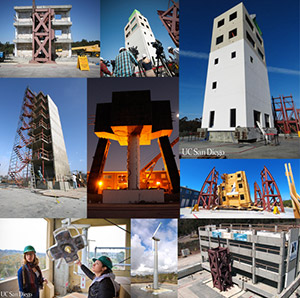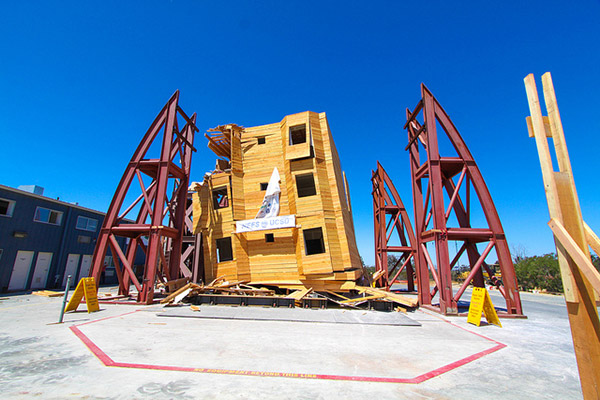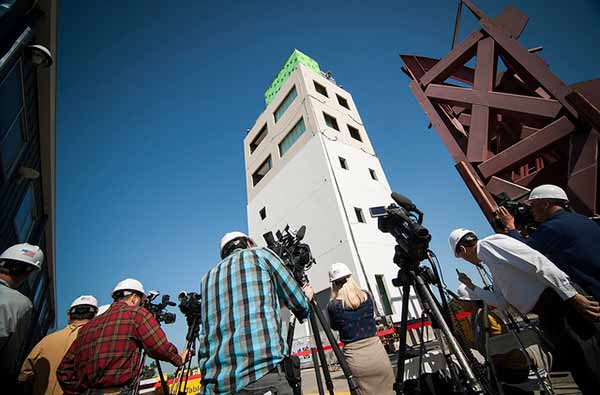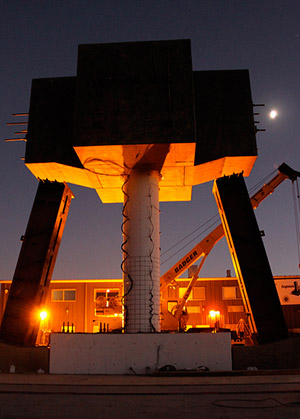
World’s largest outdoor shake table gets $5.2 million from NSF
Published Date
By:
- Ioana Patringenaru
Share This:
Article Content

The UC San Diego shake table has been used to test a wide variety of structures. Clockwise from center of top row: a five-story building equipped with non-structural components (two pictures), a soft-story wood frame building, a precast concrete structure, a wind turbine, interior of the five-story building's surgery suite, a seven-story building, a three-story masonry building and a bridge column (image at the center).
The University of California at San Diego has received a $5.2 million grant from the National Science Foundation (NSF) to run the world’s largest outdoor shake table for the next five years.
The table, which can carry structures weighing up to 2,000 tons, can replicate the ground motions of most of the world’s largest earthquakes. It has been used since 2004 as a resource for NSF-funded researchers from around the nation to test innovative technologies and designs for seismic safety of new buildings and retrofitting techniques for existing structures. The grant, awarded after a highly competitive process by NSF’s Natural Hazards Engineering Research Infrastructure (NHERI) Program, will provide funding for the facility’s operation and maintenance.
“The earthquake shake table is a unique and valuable research facility for the people of California, the nation and the world,” said Chancellor Pradeep K. Khosla. “The continued stream of research projects on the table will lead to safer buildings, bridges and renewable-energy infrastructure, advancing UC San Diego’s mission to engage in work that benefits humankind.”

Engineers shook to failure a four-story wood frame building at the UC San Diego shake table on Aug. 17, 2013.
In the past 11 years, research at UC San Diego’s shake table, which is housed at the Englekirk Structural Engineering Center, has led to important changes in design codes for commercial and residential structures and new insights into the performance of geotechnical systems, such as foundations, tunnels and retaining walls. It also has helped validate the use of new technologies to make buildings more likely to withstand earthquakes.
“We are working to continually improve design methodologies,” said Joel Conte, the grant’s principal investigator and a professor of structural engineering at the Jacobs School of Engineering at UC San Diego. “We are helping engineers come up with new concepts, new technologies and new seismic safety systems.”
Impact of research conducted on the shake table
In San Francisco, for example, approximately 6,000 buildings are being retrofitted to make them safer in strong earthquakes. Full-scale testing of retrofitting systems for these “soft-story” woodframe buildings on the UC San Diego shake table, led by Professor John van de Lindt from Colorado State University, was critical to make this possible.
“The UC San Diego structural engineers who run the shake table and steward this resource have a breadth and depth of expertise that is extraordinary,” said Albert P. Pisano, Dean of the UC San Diego Jacobs School of Engineering. “The UC San Diego shake table truly is a force multiplier for public safety in the face of strong seismic activity.”
During a one-of-a-kind test in 2011, a team led by Jacobs School structural engineering professor Tara Hutchinson investigated the safety of a building’s non-structural components--such as elevators, stairs and facades. The tests resulted in new building design requirements for the way facades are attached to the building and new construction methods for elevators, to name a few, and they will likely yield more insights in coming years.
Those same tests also validated the effectiveness of base isolation, in which large rubber bearings are installed under buildings to absorb much of the lateral motion they experience during an earthquake.
After the seismic tests, researchers led by Professor Brian Meacham at Worcester Polytechnic Institute, investigated how fire spread in the earthquake-damaged building. The shake table is the only facility in the world allowing engineers to study the impact of such secondary damage on full-scale buildings.

Reporters prepare to record a test on a five-story building equipped with a wide range of non-structural components, such as an elevator and sprinklers, at the UC San Diego shake table in April 2012.
Research by professors Jose Restrepo, at UC San Diego, and Robert Fleischman, at the University of Arizona, led to new design standards for so-called floor diaphragms, which transfer seismic forces from building floors to columns, walls and eventually foundations.
Research by Benson Shing, professor and chair of the structural engineering department at UC San Diego’s Jacobs School of Engineering, has led to more accurate methods to assess the seismic safety of older buildings that combine weak reinforced concrete frames and unreinforced masonry walls, and better retrofit methods to improve their performance during quakes.
Full-Scale Testing and Simulations
Massive amounts of data are collected from each of the tests run on the shake table through networks of hundreds of sensors. These data are made available to civil engineers around the world, who can use them to validate and increase their confidence in their own models, without having to expend the money and time that would otherwise be required to perform their own tests.
“When researchers test structures on the UC San Diego shake table, we create landmark datasets that are made available to researchers worldwide and used to validate and improve their simulation methods,” explained Conte, the principal investigator on the new NSF grant.
Over the next five years, researchers from around the nation and the world from academia, industry and government will continue to embark on ambitious projects on the shake table.
Seismic testing in the future
“Traditionally, civil engineers aim to design buildings that protect the life of their occupants even if the structures themselves sustain seismic damage,” Conte said. “But society now wants to be able to resume business as usual as soon as possible after a temblor. This means buildings have to sustain minimal damage or sustain damage that can be fixed quickly.”

Engineers tested a 24-foot bridge column on the NEES @ UCSD shake table in September 2010.
In the coming years, engineers are likely to turn to technologies such as seismic isolation and protective systems designed to minimize damage to reach this goal. Another trend is trying to design smart, adaptive, seismic safety systems. Buildings would be equipped with fine-tuned sensors that collect information about the state of the structure every millisecond during an earthquake. The data would then be transmitted to a computer that issues in real-time commands to seismic protection devices that adjust their performance accordingly. Researchers plan to test the first iterations of these systems at large scale for the first time on the shake table in 2017.
“The UC San Diego shake table can also be used in combination with large soil boxes to test and improve our understanding of how structures such as buildings and bridges, interact with the soil during an earthquake,” added UC San Diego structural engineering professor Enrique Luco. For example, engineers can study the effects of soil liquefaction on structures’ response to earthquakes and techniques to improve this performance.
Recent upgrades to the shake table will allow for more advanced testing techniques, such as hybrid shake table testing. This approach allows engineers to investigate larger and more complex structural systems by testing only critical parts of the structure on the shake table, while these parts interact in real-time with the other parts modeled in computer simulations.
“The table also will open numerous educational opportunities, welcoming more than 500 middle- and high-school students every quarter,” said Lelli Van Den Einde, co-principal investigator on the grant and a teaching professor at the Jacobs School. These students will learn about seismic safety at their schools, then test structures they build out on the table. (Learn more about Engineering Seismic Outreach and watch a video about the program.)
This grant resulted from the collaborative efforts of UC San Diego Structural Engineering professors Conte, Hutchinson, Luco, Gilberto Mosqueda, Restrepo, Shing, and Van Den Einde.
Restrepo, Luco, Conte and Van Den Einde have been involved with the shake table since its inception. The facility had previously been supported by NSF under the George E. Brown, Jr. Network for Earthquake Engineering Simulation (NEES) Program with $6.2 million for its design and construction (2002-2004), and $10.6 million for maintenance and operation (2004-2014).
UC San Diego structural engineering staff members Dan Radulescu, Robert Beckley and Alex Sherman have played a key role in the efficient operation, maintenance and upgrade of the facility.
Share This:
You May Also Like
Stay in the Know
Keep up with all the latest from UC San Diego. Subscribe to the newsletter today.



